THE LANDSCAPING SOLUTIONS BLOG
Welcome to our Blog. Inspiration, updates and industry trends from the team at Landscaping Solutions.
THE SUSTAINABLE AESTHETIC
In late 2019 we collaborated with Jilayne Rickards on a small urban garden she designed for a great client in North London. Jilayne christened the scheme ‘The Urban Retreat’.
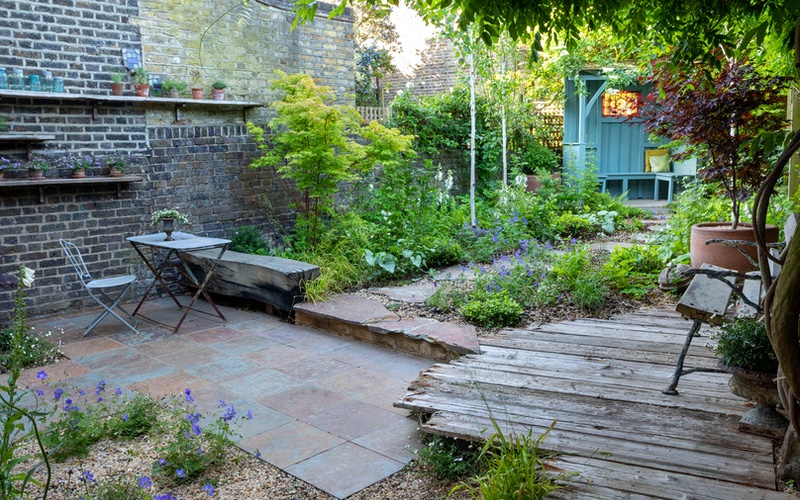
The Urban Retreat in North London, designed by Jilayne Rickards and built by Landscaping Solutions.
Jilayne’s vision was for the garden to be both beautiful and sustainable. In December last year we discovered the garden had picked up four British Association of Landscape Industries awards. The most satisfying of these for us was the award for best use of recycled and reclaimed materials. The recognition this garden received from BALI and the interest and acclaim it has garnered from the wider public offers hope for what we call ‘The sustainable aesthetic’. The more media coverage gardens of this type obtain the more they will come to be considered desirable by the general public and the more likely their guiding ethos will become mainstream thought.
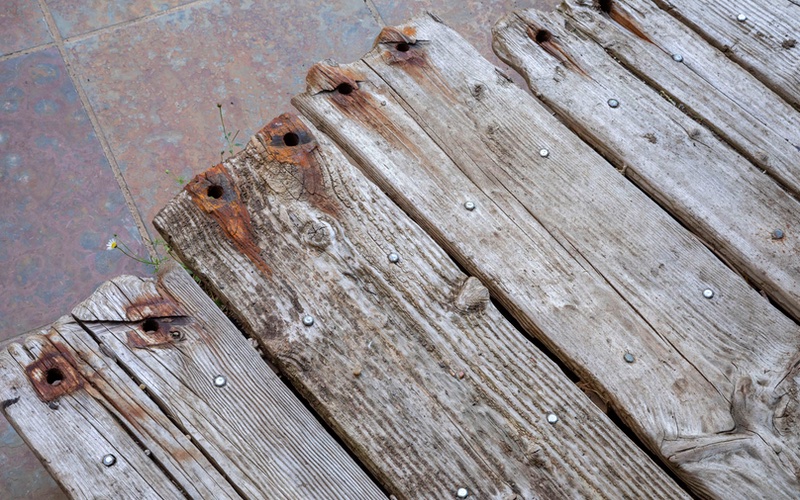
Reclaimed Douglas Fir decking, one of the many recycled and reclaimed materials used throughout the garden.
What is the ethos of the sustainable aesthetic and why is it important? The sustainable garden weathers well in the British climate, blends in with its surroundings, accommodates and encourages interaction with wildlife and does not damage the environment in its creation. It follows a number of principles;
Protect and nurture the holy trinity of soil, plants and insects. Do this and good things will follow. In ‘The Urban Retreat’ all soil was kept on site.
Reduce waste. In this garden all existing pots and planters were recycled along with the brick work. Paving sub-base materials were re-used where appropriate or sent for off-site recycling with any green waste produced. Energetic waste can also be reduced by designing closed systems and features that have multiple benefits. For example, planting Comfrey for its aesthetic appeal, ability to attract and feed insects, provision of composting material and medicinal applications.
We can further reduce waste by working with the existing lay of the land, soil type, microclimate, ‘hard’ and ‘soft’ vernacular, moisture levels, ‘habitat’ type, etc. The existing garden had a woodland edge feel and Jilayne used this to inform her plant choices. Woodland edge gardens are cooling and relaxing in the heat of a city summer.
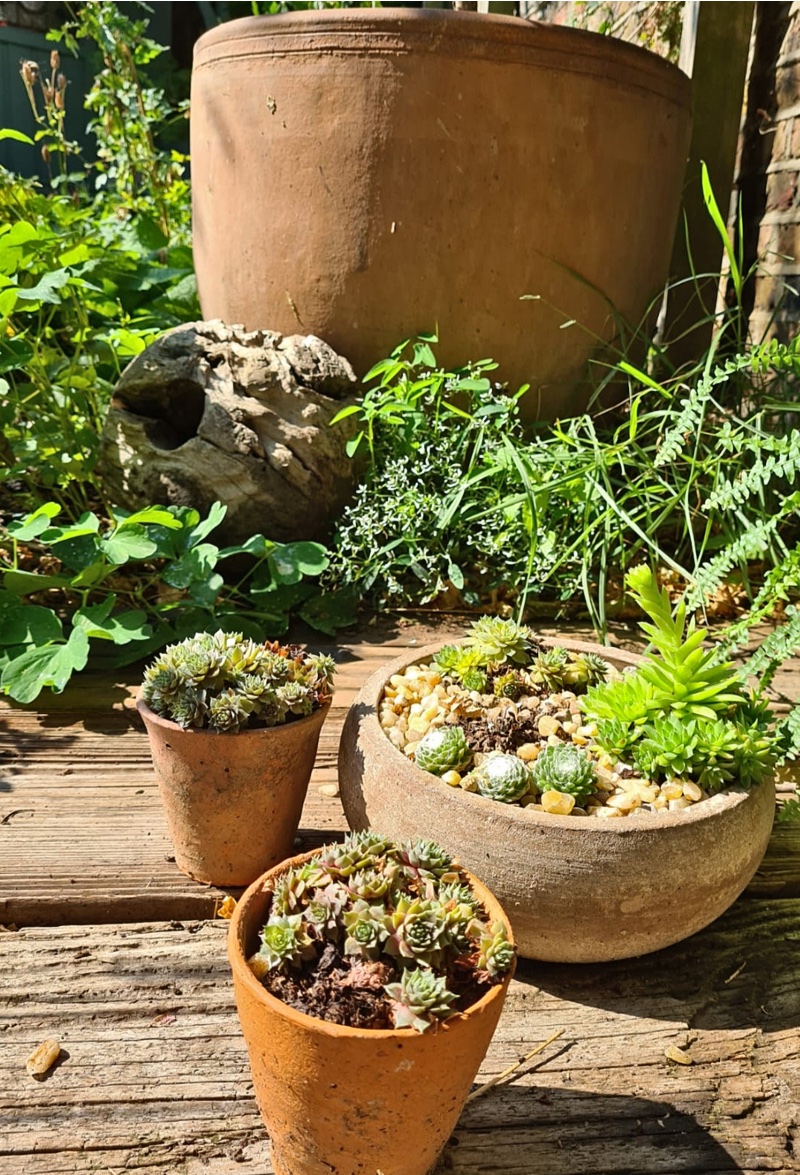
Existing pots and planters were recycled and wildlife friendly planting was retained.
Useful, wildlife friendly planting was retained and any unwanted plants were donated to other gardeners. A mature Elder was a prominent existing feature. What plant can better connect us to the environment and other lifeforms? In winter it looks a wreck and we wonder will it manage to limp on through to spring? But what a change once the sap starts to rise. The leaves come on early, connecting us to the cycle of re-birth out of decay. The summer flowers are an insect magnet and can be made in to refreshing drinks. The autumn berries feed birds and small mammals whilst boosting our immune systems through winter when processed in to medicinal food and drink. Dried out Elder canes are also the best material for the hand drill-one of the first ways our ancestors kindled fire. Try it yourself to fully appreciate their achievements! Plants of this kind re-connect us with our history and birthright and, in doing so, help dispel the illusion that we are somehow ‘outside’ of nature. Through constant exposure to the damaging aspects of our existence we have grown to believe degradation is our hallmark. Gardens are the one of the arenas in which we can reassert the positive elements of human intervention and perhaps see our purpose on this planet.
Specify plants and hardscape that don’t need mollycoddling. Opt for resilient plants and stone and timber types that don’t need constant sealing or cleaning. Reclaimed materials achieve this end and also tick the sustainability box- they have not been newly created and therefore no further finite resources have been consumed. In terms of timber, we used reclaimed Douglas Fir decking and shelving and reclaimed Oak for the seating block/retaining wall in this garden. Reclaimed slate and granite was used for the paving. Jilayne and the client went shopping in local markets for the second hand furniture, fixtures and fittings. All the reclaimed materials were of British provenance. When reclaimed wood cannot be used specify locally sourced FSC-certified timber from trusted suppliers.

Reclaimed timber, slate and granite were used throughout the garden as well as second hand furniture, fixtures and fittings.
Permeable surfaces allow rain water to percolate back in to the ground and to that end gravel was used extensively in this garden. More generally, look to make surfaces more porous with the aim of increasing biodiversity. Block and brick retaining walls could be replaced with gabions which allow unwanted existing materials such as paving and walling to be used as in-fill.
Sustainable gardens aim to be as ‘soft’ as possible. Planting should be diverse, successional and nectar-rich. Utilise a range of trees, shrubs, climbers, grasses and bulbs to provide food and shelter for wildlife. Don’t forget; attractiveness to humans is of equal importance if the garden is to be considered a success by the client!
Go easy on garden lighting and chemical weed and pest control. Neither were used in this scheme.
However, the garden wasn’t a perfect example of sustainability. There were a number of areas where our activities were damaging;
- Cement and adhesives were used. Both material have a high environmental impact.
- Fossil fuels were consumed and pollutants produced in travelling to and from site.
- Space restrictions dictated all deliveries were bagged. To reduce waste specify loose deliveries wherever possible.
- Gravel extraction degrades wildlife habitat.
How can we improve? At Landscaping Solutions we are committed to continual professional development through seminars, courses, workshops and personal study. Integration of environmental assessments to our CDM process helps us think about how we can reduce our impact and guides our landscape design decisions and installation techniques. This is a great tool but can only take us so far due to the fact that much of the raw information is based on intuition. There is a need to develop an industry accepted framework to help us better understand the relative impact of various materials and practices. For instance, we might assume artificial turf to be more impactful than paving but in some instances artificial turf allows the ground to ‘breath’ more than paving. Leave artificial turf to its own devices and it develops into ‘habitat’ much quicker than paving, rapidly hosting an array of plant and invertebrate life. However, can it be recycled satisfactorily? And which of these is most environmentally impactful; quarried British Yorkstone or Italian porcelain? What about quarried Indian sandstone v Italian porcelain? Or Indian sandstone v Indian porcelain. Yorkstone v Portland Stone? Portland stone from open cast extraction v undersea deposits? These are complicated questions.
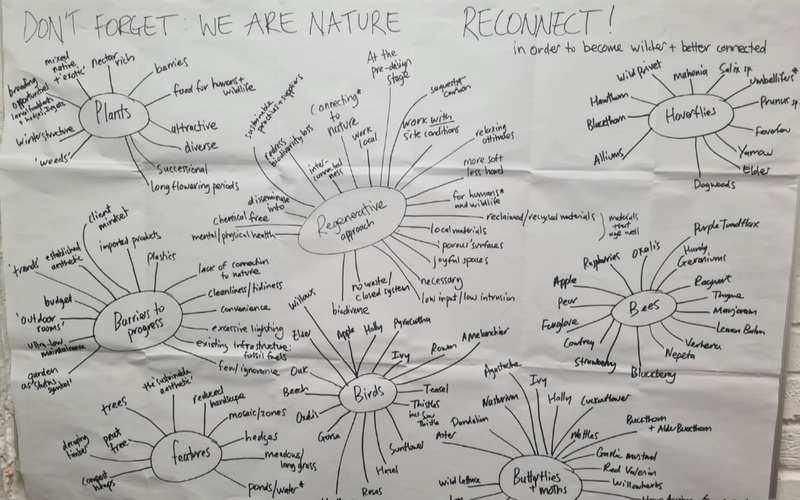
Regular brainstorming sessions helped guide our design decisions and installation techniques.
Good reliable information will enable us to compile a database of suppliers employing sustainable practices. For ‘The Urban Retreat’ we used Ashwells Timber and CED Stone.
Responsive clients might be encouraged to engage with food production be it wild or cultivated and on whatever scale possible. This takes the pressure off the industrial agricultural system, promotes personal resilience, self-sufficiency, understanding of our role in the ecosystem, empathy with other life forms and mental and physical health. Studies have shown low-input vegetable and fruit allotments to be the most biodiverse land use in the country. They can be further improved by providing a body of water and adding on-site composting facilities.
One last piece of advice; don’t forget to have fun!
AN AWARD-WINNING GARDEN DESIGN ENHANCES YOUR HOME
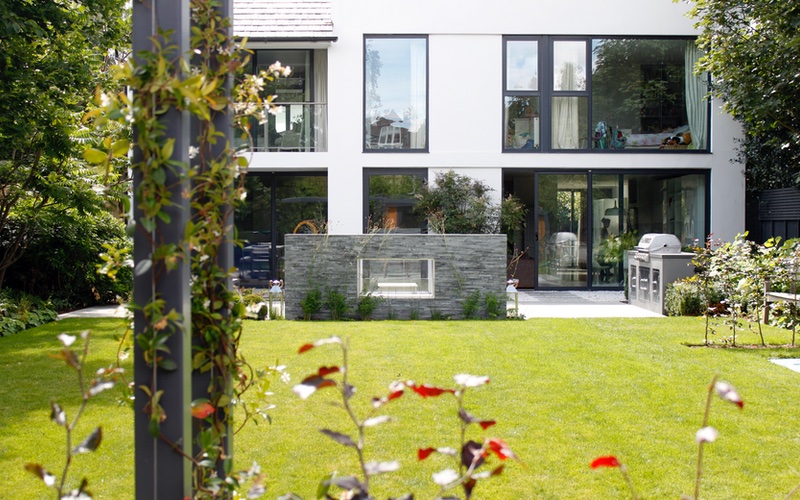
The design by Cassandra Crouch meant that the garden and house felt right together.
At Landscaping Solutions we work with some of the leading garden designers in the UK. We regard our role as providing a safe pair of hands when it comes to delivering the design, taking worry off the shoulders of both garden designer and householder. This is exactly what we did for Cassandra Crouch with this beautiful space on the edge of Richmond Park, South West London.
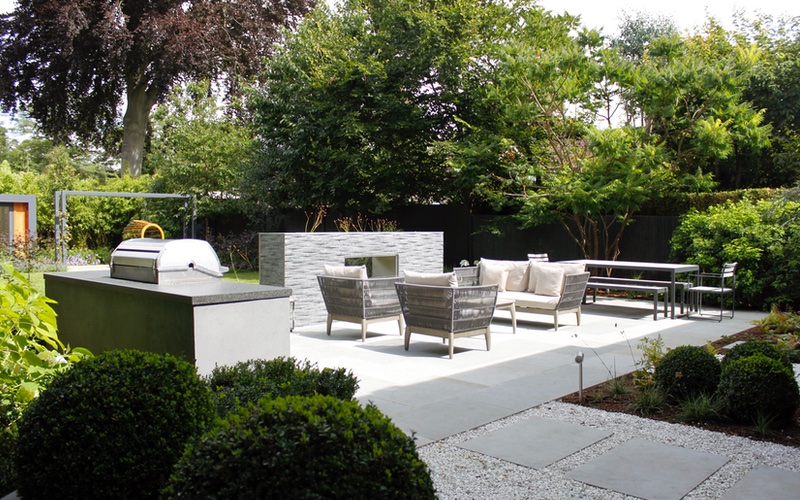
BALI award-winning garden, in South West London, designed by Cassandra Crouch.
Typical of family gardens, this one had a wide-ranging brief. It needed areas for:
- adult exercise and children’s play
- entertaining and outdoor cooking, during the day and after dark
- for rest and relaxation
- for storage
And while the clients were not particularly keen on gardening, they did want a variety of heights and textures in the planting to create year-round interest.
The house has a rectilinear, minimalist feel, and Cassandra’s design gives it a strong sense of place with the use and overlap of strong squares and rectangles in the design - even the trampoline is square. Cassandra’s Crouch’s design marries the garden to the building, creating a relaxing space that feels right at home.
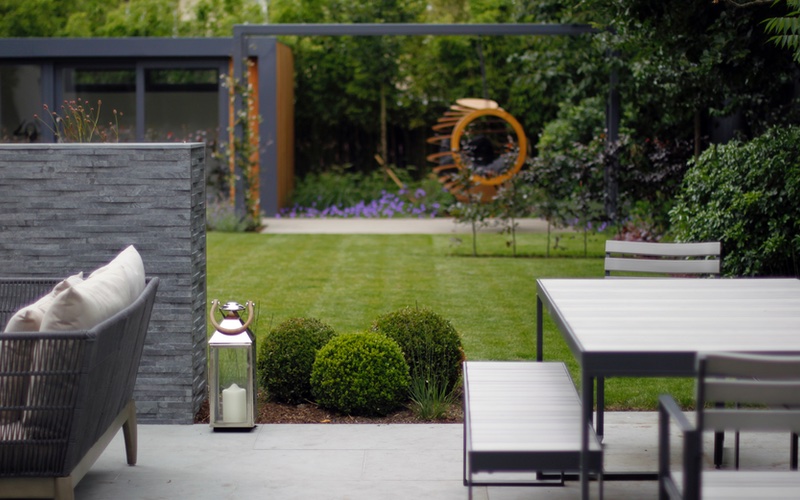
Beams made by Leighton Ironcraft support a hanging seat that offers a contrasting shape to the lines and rectangles.
Generous beams support the hanging seat; grassed and paved areas have straight edges and ninety-degree angles on their corners; the fireplace feature and barbecue are strongly rectangular.
A design like this needs a highly accurate finish - imperfections in angles and straight lines are immediately visible. At the same time, the variety of materials requires skill and experience to integrate them seamlessly, as well as very careful attention to detail to ensure that levels match and surfaces move smoothly from one texture to another.
We pride ourselves at Landscaping Solutions on creating a luxury finish. “They are passionate about construction,” says Cassandra, “and strive to achieve very high standards.”
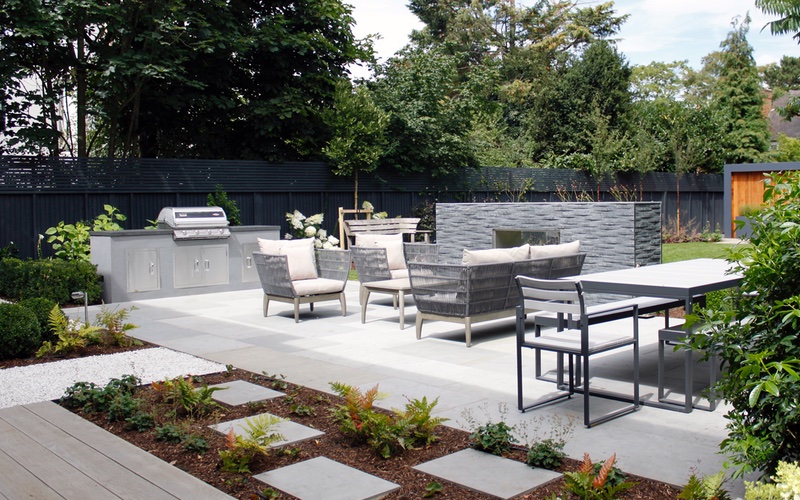
Sawn Grey Yorkstone and Smoked Oak Millboard combine textures in this garden designed by Cassandra Crouch in South West London.
High-quality materials completed the sense of luxury. The patio uses Sawn Grey Yorkstone (supplied by London Stone) which tones beautifully with Millboard’s Enhanced Grain Smoked Oak composite decking, laid at the access to the house and around the gym/studio, while adding contrasting texture.
This was a garden design that required a wide range of landscaping skills. As well as laying different materials and recycling existing paving to allow access to a storage area hidden behind the gym, we installed textured tile cladding and stainless steel beading to the fireplace, put in the barbecue and then rendered and painted its housing to tone with the overall colour scheme. Light-coloured aggregate around paving stones was retained in a stabilising system to prevent gravel migrating to beds and paving and to make a stable surface to walk on.
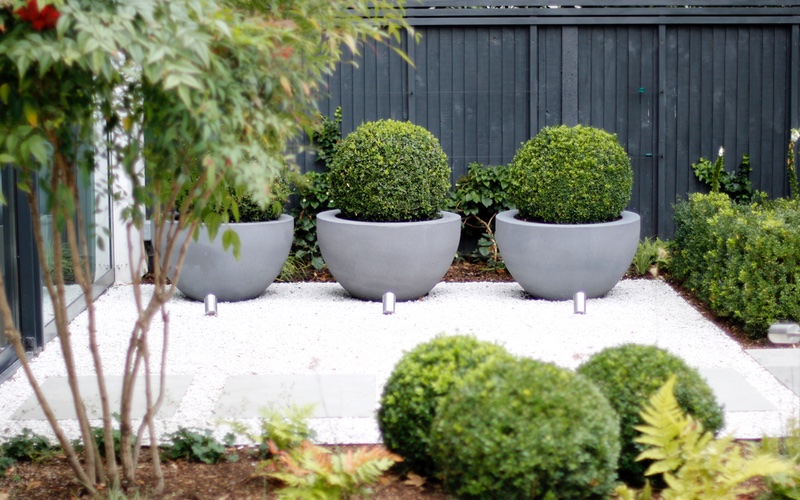
Round box balls, uplit at night, add contrasting shape and texture in a garden which the owners wanted to be easy to look after.
Lighting, which picks out shape and texture at night and focuses on the barbecue and seating area for extended evening use, was installed by Electrosafe Landscape Lighting Ltd, overseen by us at Landscaping Solutions. The drip-irrigation system, which we installed, will reduce work in the garden and ensure the survival of plants while the home-owner is on holiday.
Badgers!
So far, so normal for our teams at Landscaping Solutions. However, this build introduced an interesting additional element - badgers in a neighbouring garden.
Badgers are protected by law, as are their setts, and if works needs to be done in their vicinity, a licence is required from Natural England.
Landscaping Solutions happily shouldered the responsibility of ensuring everything was done as it should be. Natural England required the installation of night cameras to monitor sett entrances for two weeks. With no badger activity recorded, work could progress.
“I was really pleased to have had the challenge,” says Landscaping Solutions’ Ben West. “It means we learned best practice for the situation and allowed me to get up close and personal with one of my favourite British mammals. I’ve been badger-watching since I was a young lad so it was second nature for me to want to do the best by the badgers.”
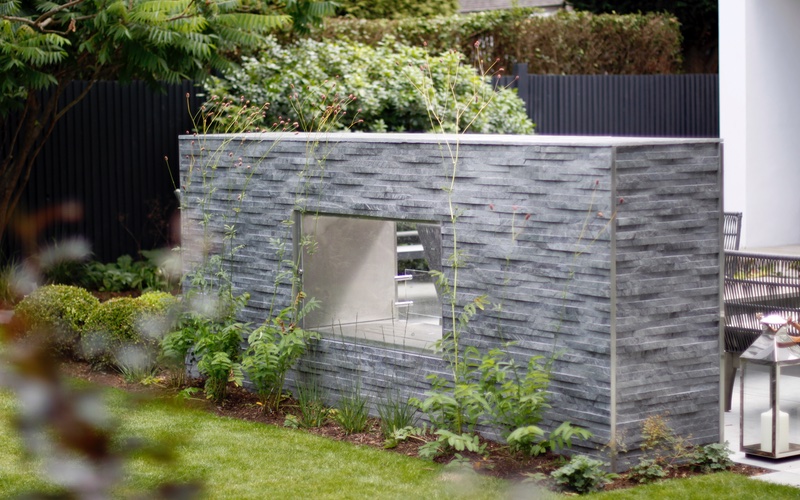
Textured tiles clad the outdoor fireplace with stainless steel beading to finish the edges.
In the meantime we shifted our schedule to make progress in other areas of the garden, away from the badger area. Good communication with garden designer Cassandra Crouch and the homeowners meant we could be flexible in our approach and work out an efficient reorganisation of the sequence of jobs required.
We completed the build in a couple of months, in June 2016. It went on to win us our fourth BALI award, and our second Principal Award, this time in the category of Domestic Garden Construction (£60K-£100K).
“The team are professional and pleasant to work with,” said Cassandra. “Both the client and myself are extremely happy with the result. I would not hesitate to recommend them to clients in the future.”
See our other award-winning gardens.
Contact Ben West to find out how we can help you create a luxury garden to the highest standards for your clients. If you’re a home-owner looking to enhance your living space, we can refer you to talented garden designers. Just get in touch to discuss.
GARDEN DESIGNER PAMELA JOHNSON
Here at Landscaping Solutions, we’ve got to know some of the garden designers we work with pretty well.
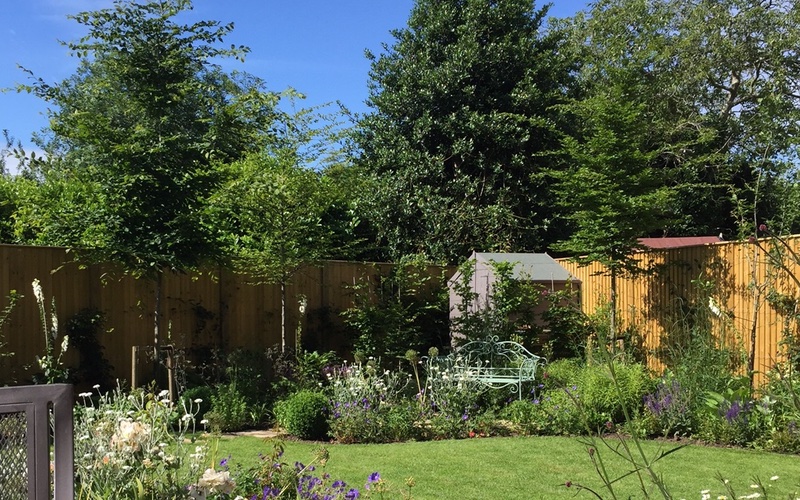
A garden in Hampton, Surrey, designed by Pam Johnson. She describes her designs as having become increasingly “planty” over the years.
One of the great pleasures of working with the same person on a variety of projects over the years is becoming familiar with another’s working practices so you virtually start from where you left off when the next garden design brings an opportunity to team up again.
“It’s the team you end up working with that’s critical,” says Pamela Johnson. Pam’s had twenty-five years’ experience in the business, training at the College of Garden Design when it wasn’t so much a growing profession, as she says, but a very small growing hobby. Things have certainly changed in a quarter of a century.
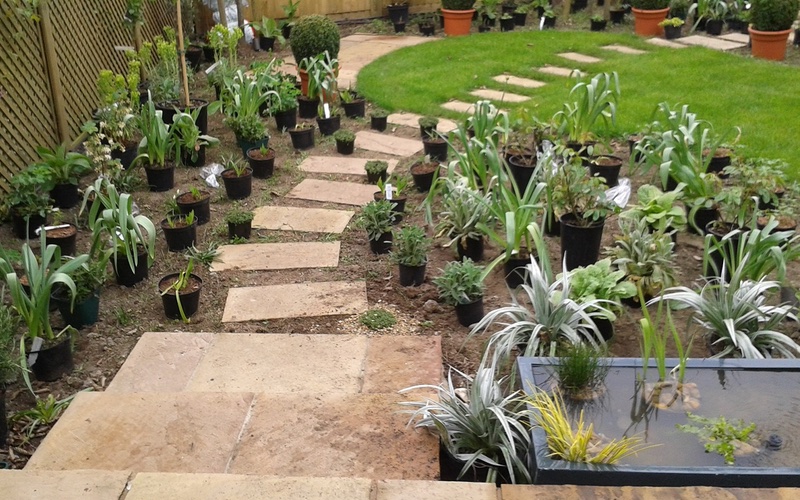
For Pam, there’s no substitute for good ground preparation. “If it’s not done properly, it’s hard to get a garden working when it all starts growing.”
Since she started, Pam has designed many gardens in and around London, but has now moved to Dorset. “I had enough of tiny London gardens and the logistics,” she says; if you’ve any experience of the problems of parking, access and spoil removal in Central London, you can probably sympathise.
While she was here, though, the result was some truly gorgeous gardens, of which we’ve been lucky enough to build a large number. Building relationships with designers is equally precious to us. “Ben’s very good with clients and good at running a team, which is critical,” says Pam, “but the next person who’s very important is the foreman.”
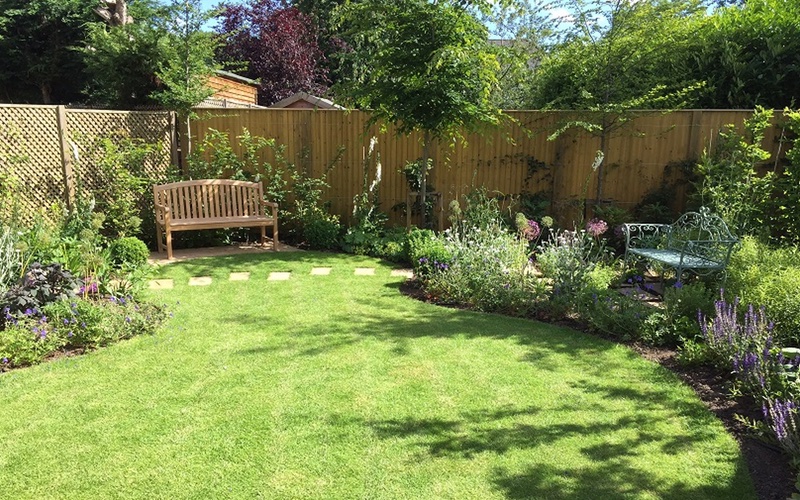
Another view of Pam Johnson’s design for a garden in Hampton, Surrey.
The foreman is the one who heads up the team on site, keeps things running smoothly, liaises with the client and keeps the designer informed on a day-to-day basis.
“As a designer,” adds Pam, “that’s the person you work with most.” Here at Landscaping Solutions we have three permanent teams and the foreman of each stays with a project from start to finish. “That’s critical, too,” adds Pam. “If a foreman has a good sense of design themselves, and an understanding of your design, is good with the client and understands your relationship with the client, then it’s good combination. If you’ve not got any of that, then it’s a nightmare. Tom, whom I worked with, is delightful, very talented.”
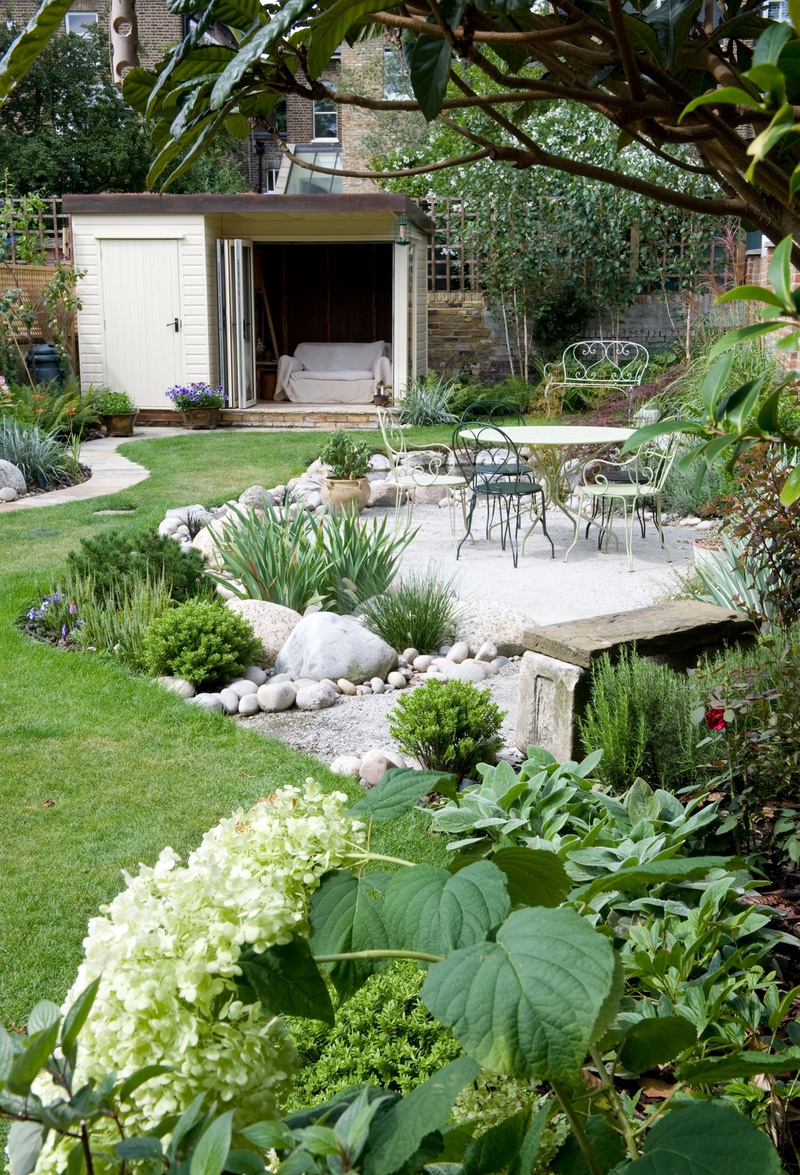
A beautifully balanced design which won a BALI award for a Surrey garden.
Pam approaches a garden very much from the point of view of the client. “I interpret within their means, manage their expectations. You don’t want something inappropriate to the circumstances. If I was to design something that I wanted, it wouldn’t fit the brief.” At the forefront is always the understanding that, as she says, “It’s not my garden, it’s the client’s garden. And it’s important for the landscaper to respect that too.”
There’s quite a skill to marrying up expectations with circumstance to create a happy solution. Some clients came to Pam because they loved the look of her own garden. “Aspirations can be tricky,” she says. “Unless you were a really good gardener, you wouldn’t be able to achieve that.”
Now in Dorset, Pam is taking a break from designing and, instead, is concentrating on working on the blank canvas of her new garden, currently mostly gravel. “It needs proper structure,” she explains, and she plans to do things gradually, seeing how they develop. “I’m doing it very slowly, rather than all at once. ‘Slow gardening’,” she laughs.
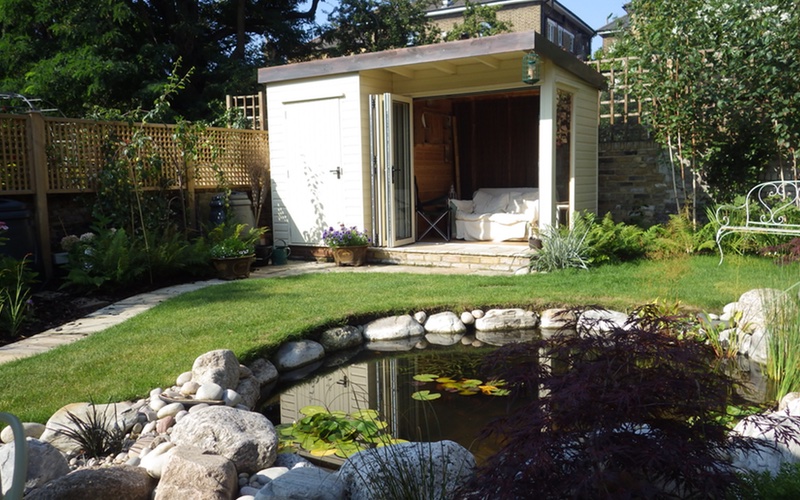
Pam used a sinuous path to echo the border of the pond in this BALI award-winning Surrey garden.
Starting when garden design was so young an occupation, Pam spent many years as a member of the Society of Garden Designers, which has presided over an improvement in working practices within the profession. “The SGD has set out quite rigid guidelines about how to conduct business, making sure everything’s done properly and professionally.”
This has turned out to be to everyone’s advantage, from the client, who knows that sensible quotations have been obtained, to the landscaper, who gets as full a brief as possible from the start. “The guidelines inform the way you deal with contractors,” explains Pam, “so you get comparable quotes for a specification. If all contractors quote for slightly different things, that means nothing.” As a client, it’s vital that your designer understands how to specify and get quotes. “There’s always an anomaly,” adds Pam, “but that’s the designer’s problem to work out.”
As anyone who’s had a garden designed and built knows, “something unseen”, as Pam puts it, is likely to crop up. If a problem occurs, it’s usually the site conditions at the centre of it. “The weather,” explains Pam, “or something buried, or a neighbour who complains.
“A landscaper can be instrumental in working something out,” she adds. “You need someone with good people skills. Ben will have a talk with a difficult neighbour and then say, ‘We had a problem, but we’ve sorted it.’ It’s great when someone does that.”
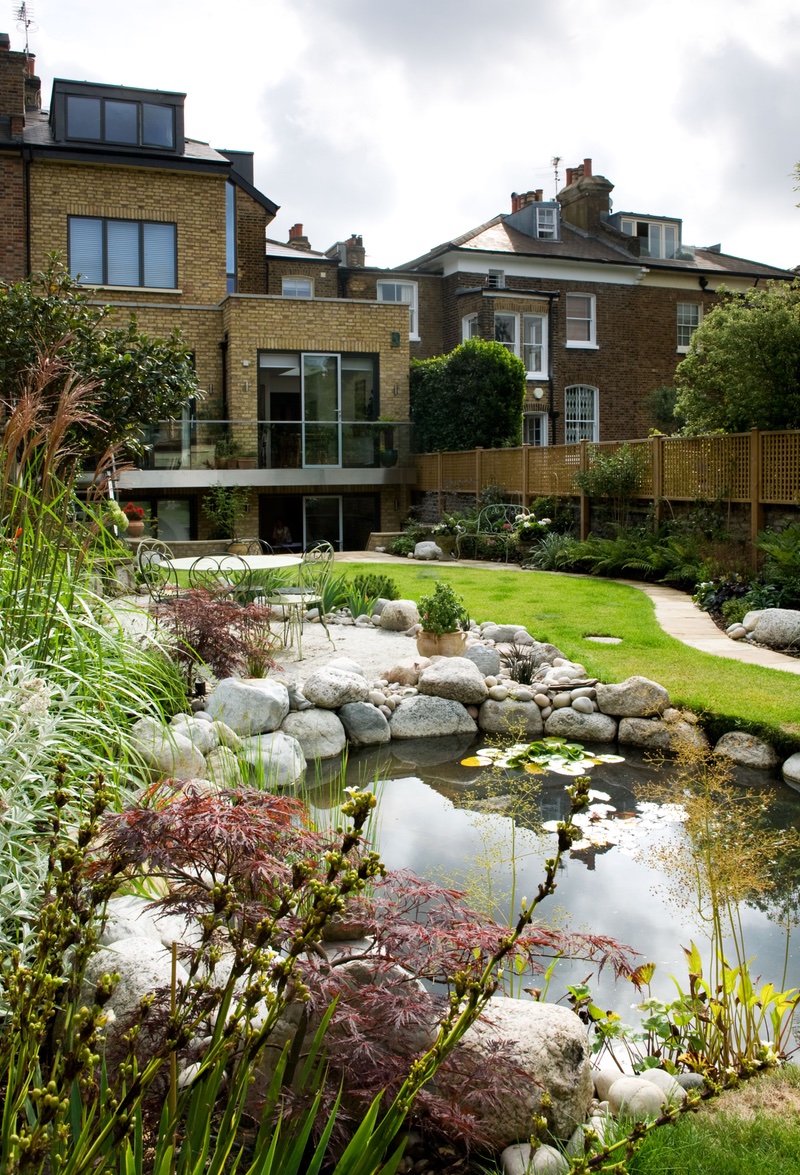
It’s important that a garden matches the needs of its owner.
Not only that, but we understand that the project we’re working on won’t be the only iron you, as a designer, have in the fire. “If you want him to, Ben’s very good at stepping in and dealing with stuff that would have been the designer’s job if, for whatever reason, the designer can’t do it,” adds Pam.
The better a designer and landscaper get to know each other and the way they work best, the easier it is to liaise and anticipate any difficulties in a build. That’s why we believe in the importance of getting to know how the designers we work with like to do things and in building up a relationship. We’re proud also to have contributed to the success of a number of award-winning gardens in London and the South-East.
Pam will eventually open her new garden for the NGS, but it won’t be very soon. In the meantime, however, keep an eye out for a blog about her new garden and courses on gardening. We’ll give you a shout on our social media when they start.
“Designing gardens is a delight,” says Pam. We couldn’t agree more!
If you’d like a chat about how Landscaping Solutions can help you achieve the design you want, then give Ben West a ring on 0208 2412402 or email info@landscapingsolutions.co.uk
GETTING THE DETAILS RIGHT IN AN AWARD-WINNING GARDEN DESIGN
There’s what you want from a garden and there’s what it and life impose on you. That’s where garden design and skilful landscaping step in - to marry the two into a something that meets your vision, services your needs and deals with its problems in a satisfactory manner. Oh, and looks good too.
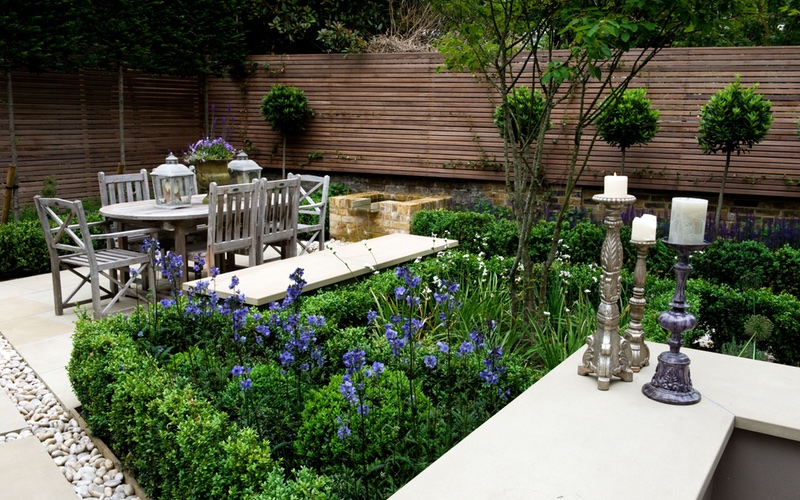
Timber slatted fencing increased the privacy of the garden while the limited palette of colour, requested by the client, added to the calm elegance.
This garden in Barnes, south-west London, designed by Justin Greer, was built by us in 2012 and, we’re proud to say, garnered a BALI award for Domestic Garden Construction (costing between £30,000 and £60,000).
What were the problems? Well, it shared issues that we see frequently in London gardens. The plot is pretty much triangular, 10 metres wide at the house, narrowing to 2 metres along its 20-metre length. For tools and toys, it needed storage space that didn’t detract from the look of the garden, and it needed a greater sense of privacy from the houses close by.
In addition, drainage of rainwater from the rear extension had to be dealt with and, as happens so often with major garden projects, enormous changes were taking place in the house at the same time, the most major being the digging of a new cellar.
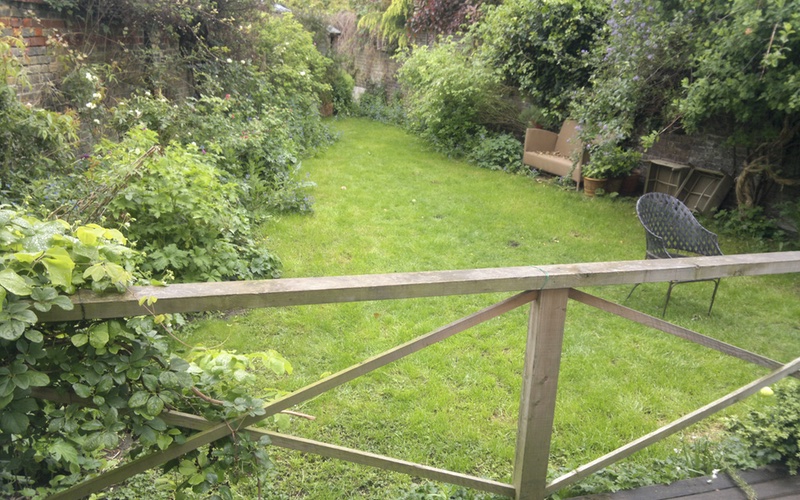
The triangular shape of the plot was very clear in the garden before its makeover.
These are merely obstacles that we meet frequently in the course of our work, however. Certainly they were nothing to interfere with our mission to remove the dilapidated decking patio and completely replace the existing unstructured and obviously awkwardly shaped garden with an enticing, more formally laid-out space that would indulge the clients’ desire to be outdoors, relaxing, dining and barbecuing with the family.
Creating the garden’s calm, relaxing atmosphere is garden designer Justin Greer’s strongly geometrical layout, with space for entertaining next to the house, a gas barbecue, a play area screened from the main garden and house. The whole has an elegant, timeless feel.
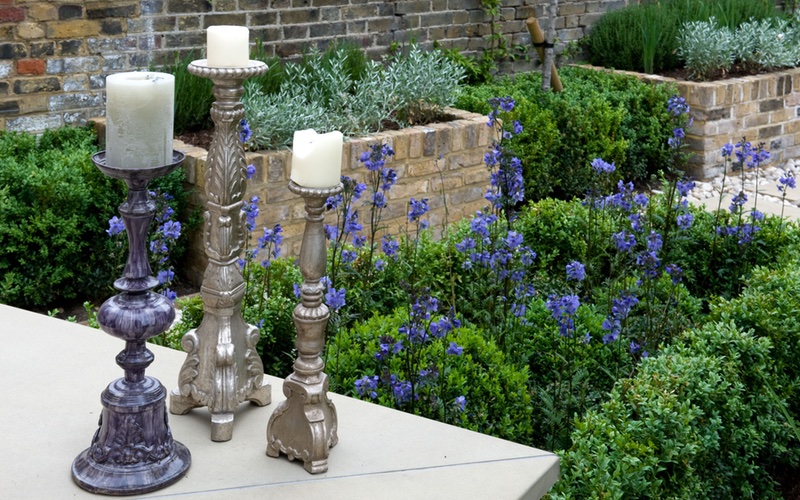
Sawn Yorkstone was used as a traditional paving and, here, benchtop, to complement the reclaimed bricks and old boundary wall.
Part of achieving this feel lies in the materials used. As anyone who’s been in an old London garden knows, the boundaries are usually tall walls, made of weathered London bricks. This was no different, but one of the boundary walls had reached demolition point, so it was replaced before we began work. This provided the ideal opportunity to create coherence in materials by matching design elements to the remaining boundary wall and we recycled the bricks into the raised beds and water feature. This required a fair amount of work in cleaning up the bricks - we also had to bring in some top-ups from the London Reclaim Brick Merchants - but it was worth it for the sense of age and history they add to the design.
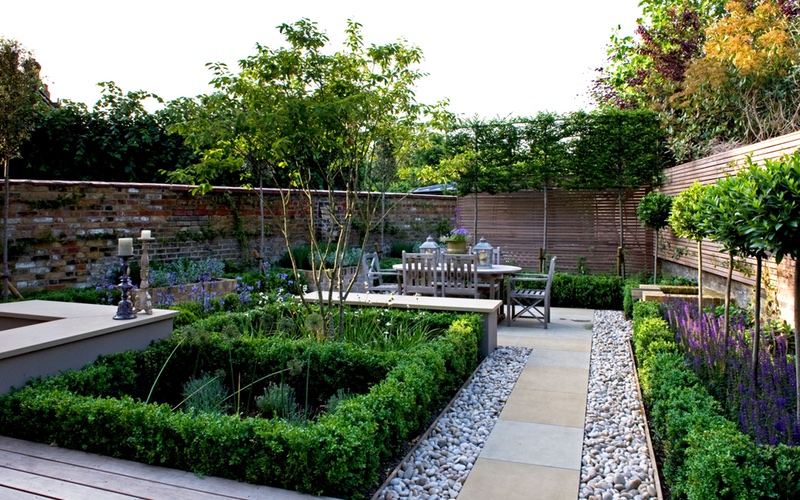
Precise planting is absolutely necessary to make a formal garden design work.
Of course, a formal feel is more easily imposed on a regular-shaped plot - think Roman piazzas or Hampton Court’s Privy Garden.
Here, the hardwood screen not only hides the play area and storage shed but squares off the space in a backdrop to the pleached hornbeams, which in combination with box hedging, standard bay trees and Quercus Ilex add the backbone of formal planting. This needs to be placed precisely for the effect to work as planned, otherwise the eye is drawn to the one trunk that’s not quite in line.
Finally, underpinning the design are the foundations that make it work - the sump for the water feature, hidden beneath the polished pebbles, is reinforced to avoid it being damaged when people walk over it; the hard-landscaped areas drain into plant border and through the polished pebbles.
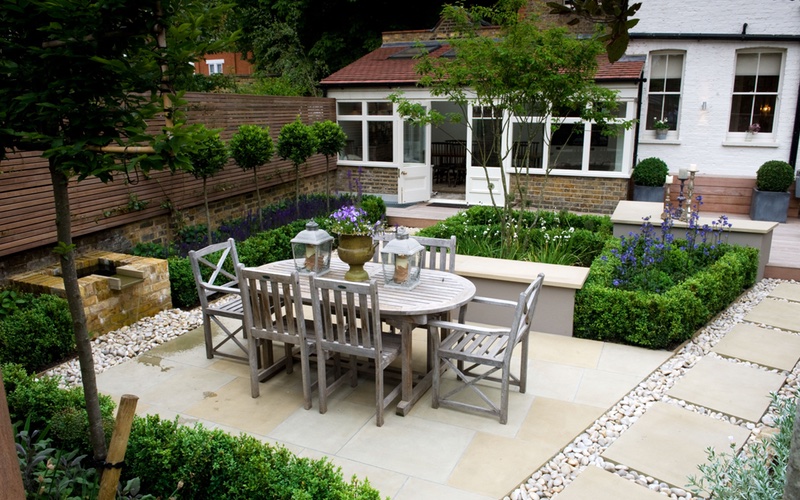
Polished pebbles create contrast with the sawn paving, as well as areas for rain to drain away.
And what about that rainwater draining off the extension? Hidden pipework takes the run-off along the east boundary and into a soak-away beneath the children’s trampoline, which was placed on artificial turf. This was to ensure the soak-away was away from the footings of the old wall, where it could have eventually made it unstable. It took careful planning and installation.
Also demanding a lot of planning, discussion, collaboration and co-operation was the fact that we had to build the deck before the light well was put down into the new cellar. As we explained in The Secret to a BALI Award-Winning Garden Design, communication is key to making sure a project runs smoothly, especially when you’re sharing the space with other contractors.
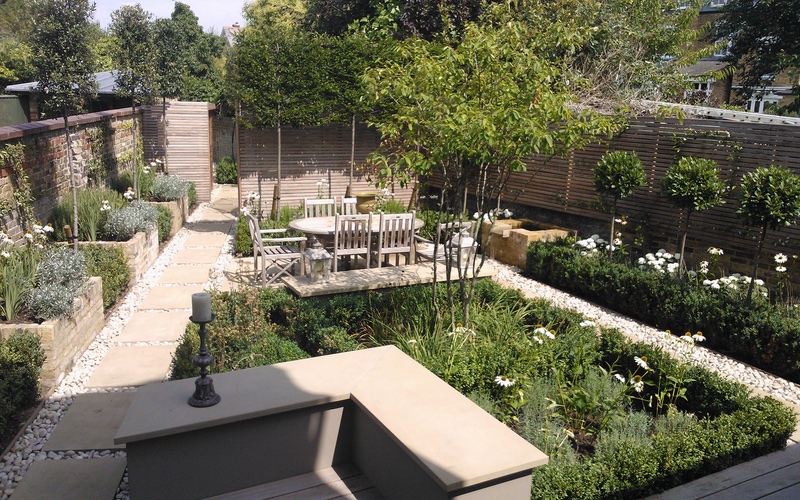
Strong horizontals slow the eye as you look down the garden, drawing attention away from the narrowing shape.
Thanks to preparation, communication and our team of skilled landscapers, the build was not only completed within the course of two months - August to September 2012 - but also gave us a BALI National Landscape Award Winner in 2013.
If you’re a garden designer and would like to discuss how we can help you with your next project, or if you have a garden would like more information on how we at Landscaping Solutions can help you with its design and landscaping, contact us on 0208 2412402 or email us at info@landscapingsolutionsltd.co.uk.